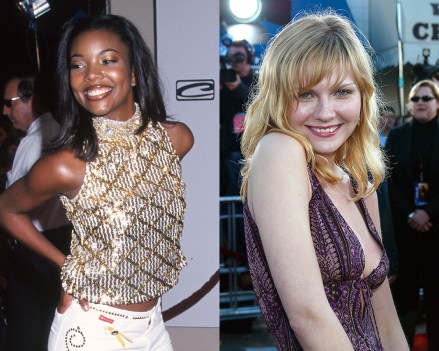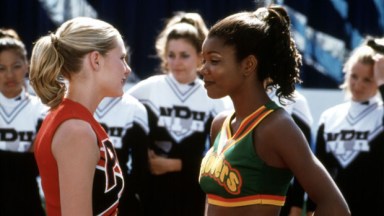
I said… it’s Bring It On’s 20th anniversary! The iconic cheer movie was released on Aug. 25, 2000, and became an instant hit. Even 20 years later, people are still referencing lines and cheers from the movie, including the legendary “Brr! It’s Cold In Here!”
HollywoodLife talked EXCLUSIVE with director Peyton Reed and writer Jessica Bendinger about everything you’ve ever wanted to know about Bring It On. From casting stars like Kirsten Dunst and Gabrielle Union to how Cliff’s love song for Torrance came to be to the ending credits, they discuss it all. Read our Q&A below.
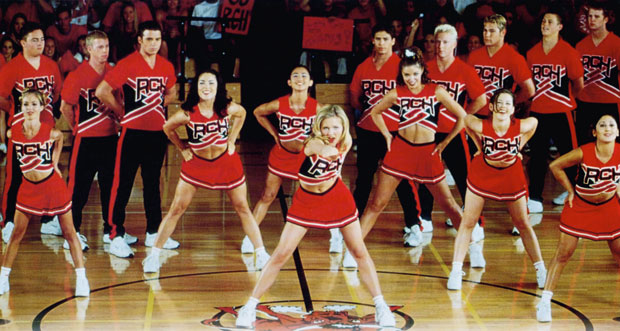
For both of you, this was your first feature film. Peyton, why was entering the cheer world something that you wanted to dive into for your first feature film?
Peyton Reed: Admittedly, for me, it was really unexpected. I’d been doing music videos and TV and had really wanted to do a movie. I’d been writing a high school movie and reading lots of things, and the things that I read didn’t really grab me. And then my agent called about a script called Cheer Fever, and it takes place in the world of competitive high school cheerleading. At that point, I really wasn’t that aware that that existed. I read it and was immediately struck by this vivid portrait of this subculture that I knew nothing about — competitive high school cheerleading. Jessica had written this hyper-specific script that took place in that world, and there were all these rules and the hierarchy of that world. I really got sucked into this subculture. I thought it was fascinating, and particularly because the first couple of pages of her script were that opening cheer almost verbatim, almost exactly as it appears in the final movie. It was so smart because it just confronted your preconceived notions about cheerleaders right off the bat. It was funny, it was musical, and very visual. From that point on, I was really hooked. But it was an unexpected journey for me because I hadn’t told my agent to find the best cheerleader movie out there.
For you, Jessica, what was the inspiration for this movie?
Jessica Bendinger: So many things. I loved the cheerleading competitions on ESPN. They were very fun binge material for me. I had done some research when I was directing music videos. I remember reaching out to Mater Dai High School, and this was like the early 90s. Mater Dai is kind of what Rancho Carne’s based on. But just the partner stunting in this music video for this very obscure hip-hop band called Tycie and Woody in New York… I just loved it. The partner stunting and the tumbling all spoke to the gymnast in me. I just thought it was so badass, and combine that with like Gwen Stefani and “Just A Girl,” there was an emerging kind of alt-rock feminism, like ironic, funny, post-punk, “I’m a joke” energy of that time. Having worked at SPIN and been in music videos, I was very aware of the musical part of the culture. It just felt right. It just felt like it lined up with what Gwen was doing in that video. There were a lot of actors kind of swirling in me and pointing me in that direction, and then there was my love of hip hop. Just getting a chance to put those two tastes together was irresistible to me.
You mentioned you were a gymnast. Was the character of Missy inspired by you?
Jessica Bendinger: One hundred percent. As Peyton has said, she’s really the eyes and ears of the audience. She’s the outsider coming into this world — as was I — so gymnastics was a great place for me to locate that. The tumbling, having been a gymnast, I knew how much hard work it was just to get your basics. Just when you’re learning round-off back handsprings, it’s brutal to put all that bodyweight on your wrists. Learning how to use force and momentum and gravity, it is a challenging sport. So I love people who excel at it. It’s just so joyful for me to watch people who’ve really committed to it and are able to transcend. It’s really a great metaphor for life about working hard and really being able to fly.
At the center of the film is Kirsten Dunst and Gabrielle Union. Without them, the movie wouldn’t have worked the way it did. What was the casting process like for both of them?
Peyton Reed: I think that’s absolutely true. They just are those characters. They brought so much to them. Jessica, I think you brought Gabrielle in first even before I came on for one of the first table reads you did for the movie, right?
Jessica Bendinger: We did a staged reading. and I think we had already cast Gabrielle for Isis. She was always Isis. There was never another Isis, and we got really lucky.
Peyton Reed: Kirsten came in later. We all knew Kirsten’s performances because she was already a veteran actor at age 17. She had just turned 17 when she came on to the movie, and one of the things we did in the casting was try to encourage those actors to bring as much of themselves to those roles as possible. That sort of central triangle of Kirsten, Gabrielle, and Eliza [Dushku] was crucial to the success of the movie. You can just put those actors in frames together and see how different they are as people. I think we got so fortunate with the casting of that movie across the board with actors because there’s a version of this movie I think that’s just playing at those characters and kind of embracing just the frothiness of the movie. We had some really talented people in front of the camera.
Jessica Bendinger: And Jesse Bradford. We were just talking about that [Steven] Soderbergh movie with him where he had to eat paper because he’s so hungry. It’s the most heartbreaking, amazing scene. I was in love with him from that moment on, and the fact that we got him was so cool. He does add so much genuine, authentic, alt-rock spirit to the proceedings, right? He’s skeptical, but he’s not cynical. There’s a real sweetness to him.
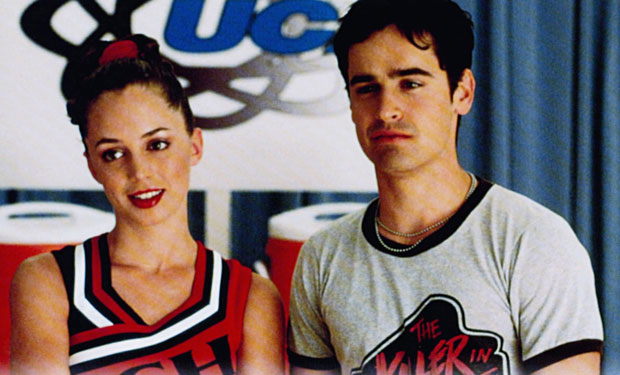
Did you see anyone else for Cliff or was he the one that you really went for?
Peyton Reed: Joseph Middleton, our casting director, brought in every working actor of that age. We saw everybody at the time. I remember James Franco coming in, Jason Schwartzman, and all these different people, but Jesse was the one who just embodied that role and how we saw that role. He was just a very soulful kid and such a smart kid. He seemed like the right amount of cynicism and the right amount of positivity, and you had to have characters like that in the movie. I think Cliff and Missy are the main ones where they represent the audience in terms of when you’re throwing these cheerleading concepts at people right away, they have their preconceived notions and just confront them right up right off the bat. So it’s important to have those points of view, and Jesse knocked it out of the park. He and Eliza, I bought them as brother and sister. They have such a great rapport in that movie. When Torrance comes to the house and is talking to Cliff about Missy being a cheerleader and he says, “Is her drug dependency going to be a problem?” It just felt like the kind of thing a sh*tty brother would say to the sister. They really got along so well. The behind the scenes chemistry was great.
One of my favorite aspects of this film is the music. Who wrote Cliff’s song for Torrance? It has been on my mind for 20 years.
Peyton Reed: Billy Gottlieb, who was our music supervisor, he found this band called Rufus King. We met with him and talked to them about what this song needed to do story-wise in the context of the movie. He had written this thing and recorded it for her. She shows up with her boyfriend at the time, and it’s a fraught situation. But it’s a song that inspires her to go back and be the captain. It had to fulfill that story requirement, but it also had to have a very Cliff attitude in the lyrics. I think we suggested lyrical concepts to them, but they really did take the ball and run with it and did this thing, which like such a late 90s/early 2000s power-pop-punk vibe that really felt like everything that was coming out of California at that time.
Another iconic scene in the movie is the Torrance and Cliff toothbrushing scene. Did that scene always have no dialogue?
Jessica Bendinger: It never had dialogue. It was actually Peyton’s idea. He was like, there’s so much lingo and chatter. There’s a lot happening in the movie musically, sonically, and he said it would be great to ventilate it and have a sweet, romantic moment and let everything breathe. We sat by my computer, and I’d been watching His Girl Friday, Peyton had mentioned It Happened One Night, and we were trying to kind of bring that old school tension and sweetness to the proceedings. I’m really grateful that he insisted and I complied because it’s one of my favorite scenes in the movie.
Peyton Reed: I’ve always been a huge fan of oral hygiene. I find it really sexy, and I wanted to share that with the world and really make toothbrushing sexy again.

Was there a reason why both squads didn’t have a coach?
Jessica Bendinger: I will have you know that I wrote a five-hour version of the movie. The pace count on the first draft was 120 pages. There were coaches, and they were mercifully cut. Coach Shelton was the coach for the Clovers, and she had one good line. Peyton had us really streamline and pull back and get to the core. I was kicking and screaming part of the way, but I think he did a great job of reining it in and finding the David in the marble.
Peyton Reed: Jessica’s original draft really did have an epic quality, and it not only had everything that’s in the movie, but it really sort of talked about and dramatized the hierarchy between the cheerleaders and the dance squad. There were the coach characters. There was a lot of stuff in there. I think as we worked on it, we just sort of focused it a little more. But the fact that all that stuff was in it upfront really kind of helped me contextually figure out what this world is and the subculture and all this sort of stuff. One day we’ll release the full cut. No, there’s no full cut.
Jessica Bendinger: There’s no Clovers cut. Somebody asked us earlier the Clovers cut of it.
At regionals and nationals, there are montages of other squads. Did you use real cheerleaders at those events?
Peyton Reed: Oh, yeah. I think we recruited almost every living cheerleader in the San Diego area. With the actors when we cast them, it was important they have a certain amount of physicality. They at least had rhythm and could do basic choreography. We obviously put them through cheer camp as well, but we wanted to surround them with people who could really do the moves because it’s not easy to fake. You had to go and get the real people, too. Those real cheerleaders would always come up and say, “You know this move we just rehearsed is technically illegal.” There were all these illegal things in the movie, but it was really good for me to have not one technical consultant, but about 300.
What was it like for you as a director to get those up-close visuals of the stunts and tumbling?
Peyton Reed: I felt kind of like a camp counselor on the movie. The whole cast was so much younger, but I definitely felt a responsibility to keep all the kids safe because that stuff is intense. I didn’t want broken ankles or concussions or anything like that. We were in the blazing sun, and it was really hot. With the routines, the Toros and the Clovers and all the other ancillary teams had to do them multiple times to get all the camera coverage. I wanted to get all this coverage but keep it as fast-paced and kinetic as possible.
The cheer mom at regionals is such a vivid memory for me because cheer moms are so real in the cheer world. Did you come across cheer moms in your research?
Jessica Bendinger: I asked some judges what the most annoying thing was for them. What were some of the unexpected things or things they weren’t prepared for? It was always the parents. I heard that from a couple different judges. The parent or coach is always coming up and micromanaging or trying to intervene when they’re not on stage. I thought that was pretty funny.
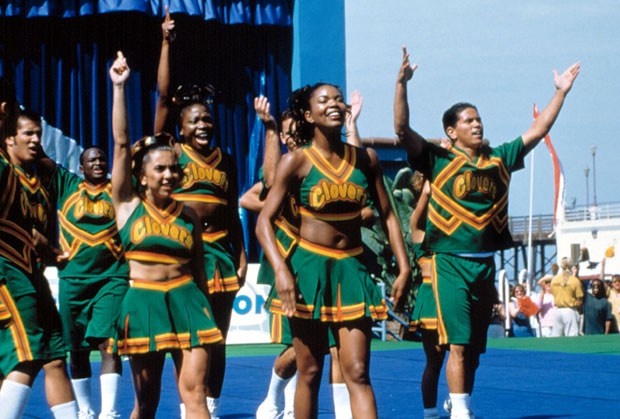
Both the Clovers and Toros had great nationals routines. Was there ever a discussion that the Toros could win or tie with the Clovers?
Jessica Bendinger: Never. It was always Rocky. It was always the Clovers who were going to win. It was always the Clovers. From the first original pitch outline, it was always the Clovers winning.
Peyton Reed: That’s just the right ending for the movie, and it’s something the movie is always building towards. I definitely looked at Rocky as a structural template because in that first movie Rocky loses to Apollo Creed, but the victory is that he’s gone the distance and proven that he’s a real contender. In this movie, it was just that the Toros for the first time are not going to have their next championship built on cultural theft. They’re going to have to try and do it themselves. The Clovers were always the better squad. The trick for me in shooting it was when we were designing those finals routines for the Clovers and for the Toros was how to make them distinct and different from each other, and how to make them both really, really great. There need to be this feeling where you felt like the Clovers were better, but the Toros were still amazing. It was finding that line, and there was a lot that went into the choreography of that. That was very tricky.
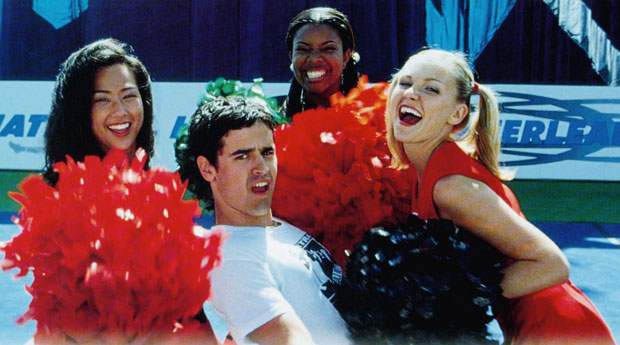
How did the “Mickey” credits happen?
Peyton Reed: Jessica and I grew up with MTV when it was brand-new, and one of the things they constantly played in the early ’80s was Toni Basil’s “Mickey.” Toni Basil was a famous Hollywood choreographer, but she became a pop star. “Mickey” was her big hit. It was all about cheerleading. Even from the time I read Jessica’s script, I was thinking: is there a place for “Mickey,” even if we just reference it in the script? And it got time to do the movie and we kept talking about the music and what to do with “Mickey.” It sort of hit us that it would be really fun to do almost like a visual curtain call with all the actors and the characters breaking character a little bit. Something that felt really loose, and we could cut outtakes into it. I remember it came together really, really quickly while we were shooting nationals in Oceanside, California. Anne Fletcher, our choreographer, was there and she just put the moves together really quickly, and we shot it really quickly. I think it benefitted from that energy and spontaneity. It was such a nice uplift at the end of the movie.
